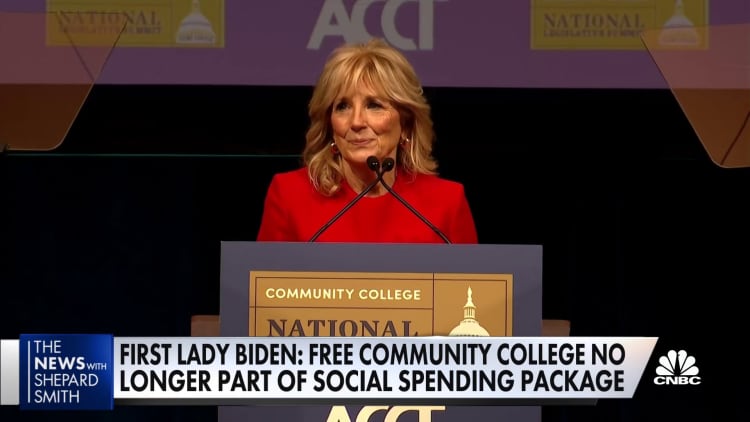From dual enrollment to course sharing, these 4 moves can help you save big on college costs
From dual enrollment to course sharing, here are some of the best, and often underrated, ways to cut college costs.

These days, students and their families have to be proactive about cutting college costs.
"It used to be, get into the best school you can get into and then figure out how to pay for it," said Kalman Chany, a financial aid consultant and author of The Princeton Review's "Paying for College."
Now, Chany says, "that's a recipe for disaster."
As inflation heats up, tuition alone at many colleges and universities is prohibitively high. About 83% of high school students said the current economic conditions have affected their ability to pay for college, according to a recent survey by scholarship search site ScholarshipOwl.
More from Personal Finance:
College is still worth it, research finds
Apprenticeship programs are becoming more popular
The cheapest states for in-state college tuition
Further, 88% plan to work part- or full-time to afford school. But there are other ways to rein in costs.
Even if you don't have a well-funded 529 college savings plan, a few tried-and-true money-saving techniques can help.
Here are some of the best — and often underrated — options for high schoolers.
1. Take college courses in high school
Dual enrollment is a state-run program that allows students to take college-level classes, often through a local community college, while they are still in high school.
As many as 3 in 10 community college students are in dual enrollment programs, according to the American Association of Community Colleges.
Unlike Advanced Placement, the program in which high school students take courses and exams that could earn them college credit, dual enrollment credits are more likely to transfer.

In some cases, students may even be able to complete an associate's degree by the time they finish high school, a process known as "early college."
Over four years, early college programs cost about $3,800 more per student than traditional high school, according to one study. However, the estimated return on that investment is about $33,709 in increased lifetime earnings.
Before committing, research your state's program to check the requirements and see how the credits will apply toward a degree.
2. Pile on Advanced Placement credits
Similarly, taking AP classes in high school — and scoring at least 3 out of 5 on the official exams at the end of the course — can earn students credit hours once they are in college.
Potentially, the more AP classes that a high school student can bank now, the fewer college courses they'll have to pay for later — as long as the college gives credit for that coursework.
According to the College Board, the average student takes three AP exams over the course of their high school career, which means, if successful, you could reduce your time in college by an entire semester, potentially saving up to $15,000 or more.
But check the guidelines on Advanced Placement first. Each college has its own policies for awarding credit — although just completing the coursework may give you a leg up.
"APs work more to show that you excelled in high school," said Hafeez Lakhani, founder and president of New York-based Lakhani Coaching, which helps during the college application process.
"It's one of the most trusted ways to show you are challenging yourself with an advanced curriculum."
3. Transfer from community college
A two-year program is not necessarily an alternative to a four-year degree. Increasingly, students go from community college to a four-year school.
"It's a very smart way to start your higher education," said Martha Parham, senior vice president of public relations at the American Association of Community Colleges. "A state university is about three times the cost for the same first two years."
A state university is about three times the cost for the same first two years.
Martha Parham
senior vice president of public relations at the American Association of Community Colleges
At two-year public schools, tuition and fees are $3,860 for the 2022–2023 academic year, according to the College Board. Alternatively, at in-state four-year public schools, tuition is $10,940 and at four-year private universities it averages $39,400.
Today, about half of all community college students go on to earn a bachelor's degree, according to data from the National Student Clearinghouse Research Center.
At least 35 states even have policies that guarantee that students with an associate's degree can then transfer to a four-year state school as a junior.
4. Try course sharing
If you are already enrolled in a four-year school, tapping community college courses can still be a worthwhile way to cut costs, a strategy known as course sharing.
In this case, students may be able to take a class at their local community college over the summer or at night and have it count toward their coursework.
In the wake of the pandemic, the online offerings have improved dramatically, making it even easier for students to work in classes from other institutions that are either less expensive or more accessible, keeping them on budget and on track for graduation.
"Sometimes those same courses are going to be cheaper at a community college," Chany said. However, there is still the risk that those credits won't count.

Compare the classes at community college with what's offered at the four-year school, Chany advised. "If there is not a similar course offered at the four-year school, then likely the credits for that course at the community college will not be transferable, defeating the main purpose of this option."
This is where students must advocate for themselves, according to Jay Field, senior vice president of institutional partnerships at Quottly, a platform for course and program sharing between colleges.
Call the college, speak to someone in the registrar or admissions office and an academic advisor, he said.
"Don't talk to your cousin Jimmy who took one class in 2002; it may be different now," Parham added. "Colleges want to help you succeed, so don't be afraid to reach out."

 KickT
KickT 





























![Is Your SEO Strategy Built for the AI Era? [Webinar] via @sejournal, @hethr_campbell](https://www.searchenginejournal.com/wp-content/uploads/2025/07/6b-240.png)


